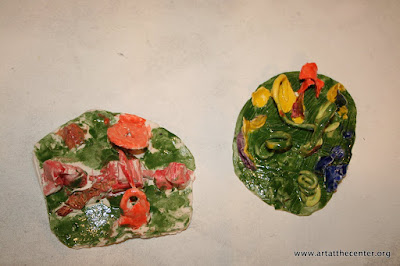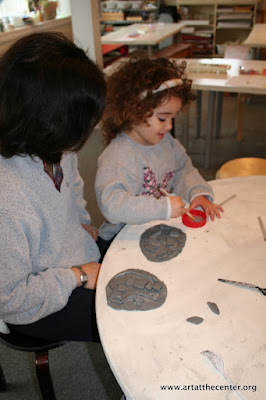For our last class, Family Studio began with circle drawings, or mandalas. Kathryn and I explained to parents that this could be used as a centering or calming activity. Some of the adults shared stories of families and teachers who have used this activity as such, in their homes and classrooms.
After this opening activity, the families moved on to make mosaics. Each child and parent could choose between a wide assortment of colored glass river rocks and other items.
Then they placed these items on a clear plate in a pattern or design that they liked and adhered each piece on with a strong non-toxic glue.
The glue takes a while to dry but when it does, it dries clear. The mosaics can then be hung in a window or somewhere where sunlight can shine through.
Families were also able to take home their glazed and re-fired clay sculptures. They all came out so beautifully! If you need a reminder of what they looked like glazed, but unfired, you can see them on my last blog. It was a great last class!
In our final Saturday Studio class, students were asked to pick some of their favorite pieces of artwork from their portfolios and write about them. They could give the piece a title, write an artist's statement, or write what they want others to notice about the piece. Then, they hung each work with its writing up on the wall.
After going through their portfolio of work, students were then able to pick their final project. Seeing all their previous work helped them decide what activity they wanted to do with the time they had left.
The classroom became a hodgepodge of creative activity. Some students decided that they wanted to do some color mixing and paint.
Other students decided to make weavings with yarn.
And others, wanted to finish glazing some of their fired clay work. These students will get to come back and pick up their final pieces in a week or two.
One thing that I will never forget about this group of students is how supportive and encouraging they were to each other, always respecting each others' creative process and individuality.
At the end of class, we took a few minutes to share about the artwork that students chose to hang on the wall and the new artwork they created during this last class. It was a great closing to all these weeks of creativity.




















































